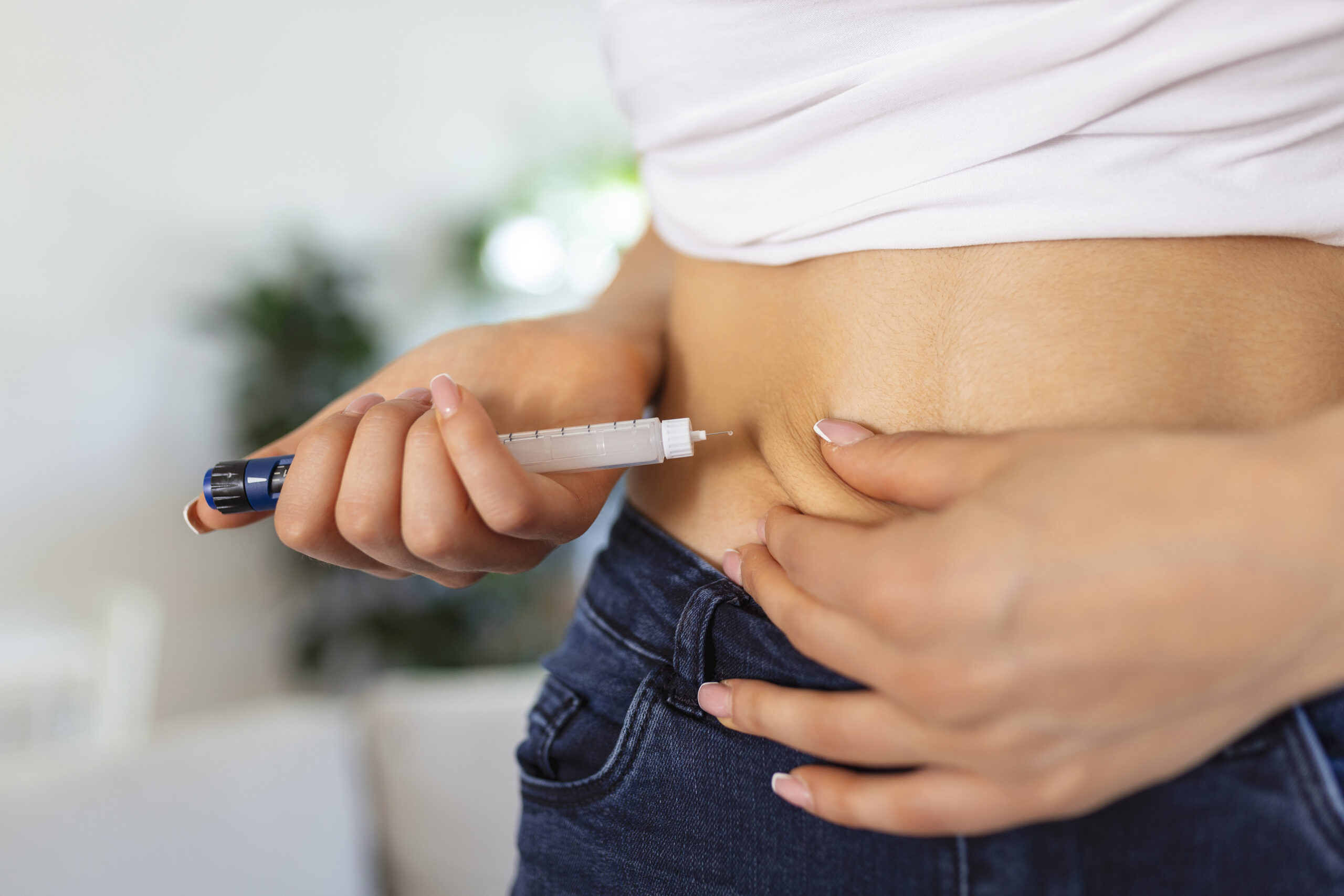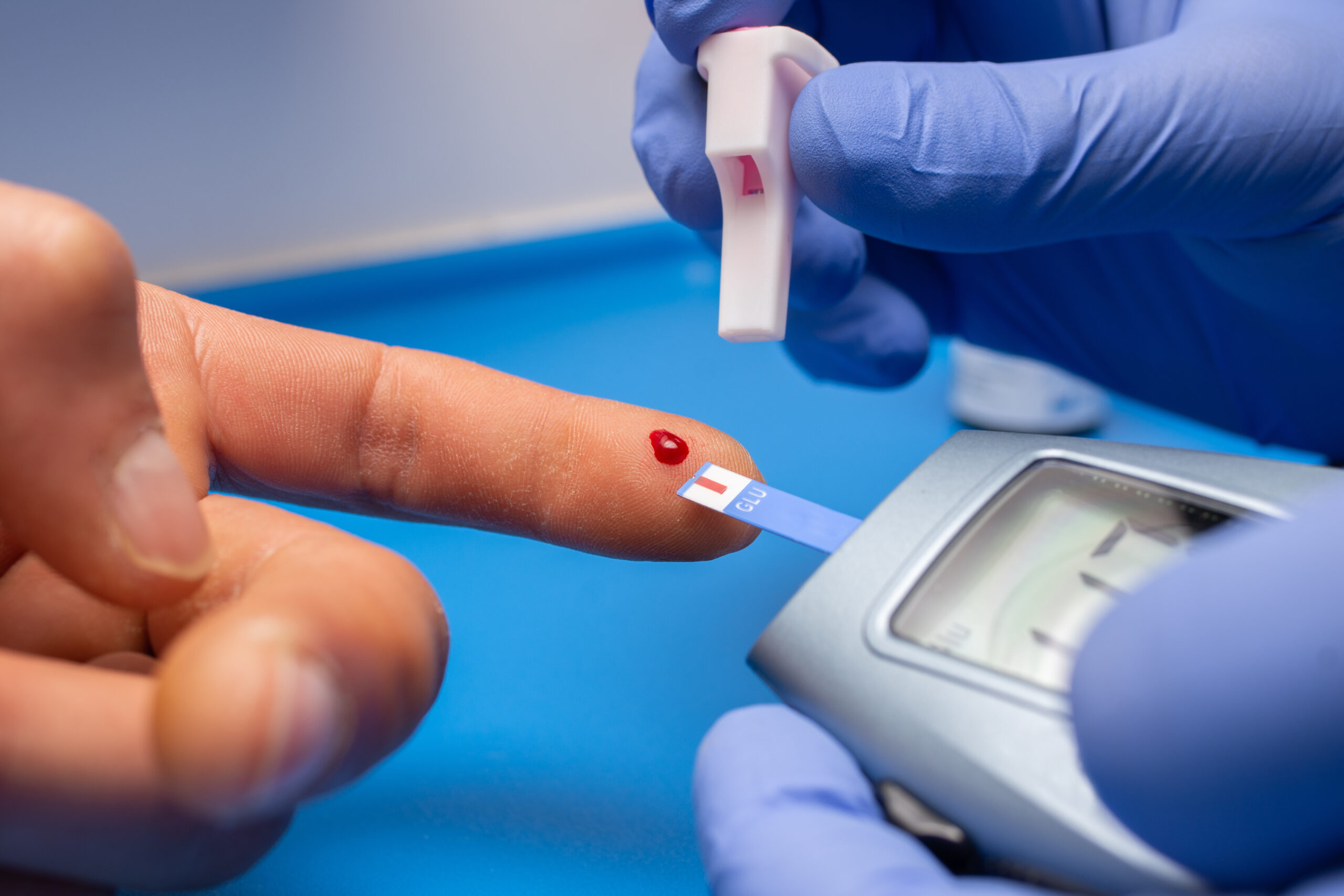Blood sugar testing primarily aims to identify diabetes. We do it using a glucometer – a device that provides test results within a few seconds.
When to test blood glucose levels?
The material needed to determine the glucose level is a blood sample taken from a vein (usually in the elbow pit) or, in the case of home testing – a drop of blood from puncturing the skin (usually from the fingertip of the hand).
Glucose![]() is a fundamental sugar. It acts as the principal energy provider for the whole body. We obtain complex carbohydrates through food, which break down into glucose and other basic sugars. First, it is absorbed by the small intestine. Then it is carried via the bloodstream. It travels to all cells across the body. Most of the body's cells need glucose to produce energy. It helps to carry out chemical reactions. That is necessary for their functioning.
is a fundamental sugar. It acts as the principal energy provider for the whole body. We obtain complex carbohydrates through food, which break down into glucose and other basic sugars. First, it is absorbed by the small intestine. Then it is carried via the bloodstream. It travels to all cells across the body. Most of the body's cells need glucose to produce energy. It helps to carry out chemical reactions. That is necessary for their functioning.
For nerve cells and erythrocytes (blood cells that transport oxygen), glucose is the only energy source. These cells can only function under one condition. It is if glucose is above a certain level. That is why we often feel weak when the sugar level drops – our brain informs us that the amount of glucose supplied is insufficient.
How our body utilizes sugar depends on insulin![]() – a hormone the pancreas produces. Insulin acts as a traffic controller – it decides whether glucose from the blood gets inside the cells or is stored as a supply in the form of glycogen or triglycerides. Life without glucose or insulin would be impossible, which is why it is so significant to maintain the levels of these substances in certain ranges.
– a hormone the pancreas produces. Insulin acts as a traffic controller – it decides whether glucose from the blood gets inside the cells or is stored as a supply in the form of glycogen or triglycerides. Life without glucose or insulin would be impossible, which is why it is so significant to maintain the levels of these substances in certain ranges.
In a healthy person, the glucose level may increase. It happens after eating. This is slight. It is a result of the consumption of carbohydrates. What happens when our sugar levels are high? The pancreas secretes insulin to bring them down. It is determined by some factors. For example, the quantity and quality of the food we eat.
What if glucose levels drop too low? It sometimes happens between meals. Also may occur after strenuous exercise. Then glucagon is released. It is another hormone produced by the pancreas. Then the liver receives information about the need to re-convert glycogen (energy reserve stored in this organ) into glucose. It will restore the normal level of this sugar in the blood.
If the control mechanism works correctly there's no problem. And blood glucose levels remain relatively constant. In turn, when this balance is disturbed and the amount of sugar in the blood increases, the body tries to normalize it by increasing insulin production and glucose excretion in the urine.
Severe, sudden hyperglycemia![]() or hypoglycemia
or hypoglycemia![]() can be dangerous and cause:
can be dangerous and cause:
Long-term high blood sugar levels lead to the progressive destruction of organs. For example, the kidneys, eyes, and heart, are endangered. Also, blood vessels, nerves, and the brain.
Some women may develop diabetes during pregnancy. It is called gestational diabetes![]() . Improper diagnosis and treatment of this condition can lead to an increased risk of having a baby with high birth weight, known as macrosomia, which can make vaginal delivery challenging and result in low glucose levels. After pregnancy, diabetes usually disappears in most cases.
. Improper diagnosis and treatment of this condition can lead to an increased risk of having a baby with high birth weight, known as macrosomia, which can make vaginal delivery challenging and result in low glucose levels. After pregnancy, diabetes usually disappears in most cases.
Symptoms of hypoglycemia![]() include as follow:
include as follow:
What if your blood sugar level drops? You might encounter the initial signs of hypoglycemia. For example, sweating, dizziness, or lightheadedness. You can determine if your blood sugar is low. Use a glucometer or other glucose-monitoring equipment.
In case you lack access to the necessary tools and begin to feel the symptoms of low blood sugar, it is recommended to consume 15 grams of carbohydrates or a fast-dissolving glucose tablet to increase your blood sugar levels and prevent further symptoms. Once your blood sugar is within the appropriate range, you may have a snack or meal to prevent it from dropping again.
Here are some other lifestyles and treatments that can help minister hypoglycemia:
Symptoms of hyperglycemia![]() , including diabetes:
, including diabetes:
How to diagnose hypoglycemia? Three conditions must be met simultaneously. It is the so-called Whipple's triad![]() :
:
Lifestyle changes can help with hyperglycemia:

Diabetics need to check their glucose levels regularly. It happens even several times a day. Regular exams help choose diabetes medications. Self-monitoring is performed with the use of a glucometer. After a small skin puncture – place a small amount of blood on a paper strip, then insert it into the meter. Based on this result, the device reads the glucose level.
The first way is the finger-prick method![]() . At any given time, you can determine your blood sugar level. Testing with this method takes a moment.
. At any given time, you can determine your blood sugar level. Testing with this method takes a moment.
The doctor will show you how to perform the test. It's significant to learn the correct way of doing it. This will help avoid getting inaccurate results. For some people, measuring their blood sugar is no problem. That is why it quickly becomes part of their daily routine. For others, this can be a stressful experience. And that's completely understandable.
The lancet used in finger-pricking devices penetrates the skin to draw a blood drop for testing. The depth of skin penetration can be tailored to match its thickness.
Lancets are available in a variety of sizes and thicknesses. They are disposable. Always wash your hands thoroughly before puncturing.
You can also use a glucometer![]() . Ask your doctor which model will be appropriate for you.
. Ask your doctor which model will be appropriate for you.

The doctor will instruct the patient on how to do this the first time, but here are the key steps.
To get an accurate result, it's significant to wash your hands with soap and warm water before testing your blood glucose levels. Avoid using wet wipes. It is because glycerin can impact the test result. Ensure your hands are warm. This is to make the process less painful. And it is easier to obtain blood. Insert the test strip into the meter to turn it on. Some blood glucose meters come with built-in test strips.
To begin, remove the cap from the finger lancet device. Insert a fresh lancet. Replace the cap. Position the device by either pulling or clicking on the plunger. Next, select which finger to use, but be sure to avoid the thumb or index finger. Also, avoid pricking the center or too close to the nail. To use the device, position it against the side of your selected finger and push down on the plunger. It is significant to use a different finger and area each time.
To take a blood sugar reading, begin by using the meter and test strip to apply a drop of blood. Once the strip is full, the device will emit a beep. Before checking the result, make sure to clean your finger and stop any bleeding using wipes. Dispose of the lancet in a designated bin. The meter should display the result by this point, which you should note down. Use the same tissue to remove the test strip. Then throw it away. Turn off the meter.
Your doctor may request that you undergo an HbA1c test. This may be at least once a year. It happens in addition to your routine blood sugar testing. Diabetics need to do this test every 2-6 months.
Glycated hemoglobin![]() (HbA1C) measures your most recent average glucose level. You don't have to fast on the day of the test as it is an average measurement. The test determines the percentage of red blood cells. Some of them are attached to glucose. The test measures glucose levels over the past 2-3 months.
(HbA1C) measures your most recent average glucose level. You don't have to fast on the day of the test as it is an average measurement. The test determines the percentage of red blood cells. Some of them are attached to glucose. The test measures glucose levels over the past 2-3 months.
Urine![]() usually does not contain glucose. Our kidneys play a vital role in filtering our blood. They retain important substances that our body needs while eliminating waste products. The kidneys constantly absorb glucose. So it does not get into the urine. What if the glucose level goes beyond a certain point? The kidneys cannot reabsorb all of it. This results in releasing it in the urine.
usually does not contain glucose. Our kidneys play a vital role in filtering our blood. They retain important substances that our body needs while eliminating waste products. The kidneys constantly absorb glucose. So it does not get into the urine. What if the glucose level goes beyond a certain point? The kidneys cannot reabsorb all of it. This results in releasing it in the urine.
A simple strip test can detect glucose in a urine sample. A chemical strip is dipped into a urine sample. The strip's color changes indicate the presence of glucose in the urine sample. If glucose is present, it may be a sign of diabetes.
What if glucose is present in your urine? It could indicate that your kidneys are more permeable. Glucose is leaking into your urine. It happens even though your blood glucose levels are normal. To confirm or rule out diabetes, undergo a blood test.
Diabetes is the most common cause of higher glucose levels![]() . We talk about both types. Various factors can lead to high blood sugar levels, such as:
. We talk about both types. Various factors can lead to high blood sugar levels, such as:
Blood sugar testing has low or no risks or side effects. The possible dangers are the same as with all blood tests. These risks include:
However, these symptoms should disappear within a day.
Lowering blood sugar is possible thanks to the diabetic diet![]() . It is recommended to eat complex products with a low glycemic index. In addition, the way of preparing meals is significant. Do it preferably without added sugar and fat.
. It is recommended to eat complex products with a low glycemic index. In addition, the way of preparing meals is significant. Do it preferably without added sugar and fat.
Contrary to popular opinion, the diet for diabetics can be tasty. Diabetes limits the consumption of many products, but you can compose an appetizing menu.
To start, it's important to cut out easily digestible carbohydrates. Simple sugars, i.e., sweets, fresh fruits, and fruit juices, must disappear from the daily menu. Simple sugars can be replaced with complex sugars.
For diabetics, their diet should exclude animal fats. While incorporating vegetable fats instead. It is also significant to introduce fish to the menu, which is rich in fiber. Proper product selection is good for maintaining a healthy weight. Also reduces the risk of hypertension and high cholesterol.
Numerous products can aid in reducing glucose levels. It includes:

Add systematic physical effort to lower your glucose level. With increased physical training![]() our body uses sugar to produce energy. The necessary dose of exercise is about 150 minutes a week. Remember to choose an activity to challenge yourself. But not torment you. It is better to pick moderate exercises that are motivating and bring pleasure. For example – hiking, dancing, swimming, and jogging are great for long-term results.
our body uses sugar to produce energy. The necessary dose of exercise is about 150 minutes a week. Remember to choose an activity to challenge yourself. But not torment you. It is better to pick moderate exercises that are motivating and bring pleasure. For example – hiking, dancing, swimming, and jogging are great for long-term results.
Experts suggest that stress![]() can raise glucose levels, making it advisable to adopt a calmer lifestyle whenever possible. You can try many relaxing technics like journaling, meditation, yoga, or mindful breathing.
can raise glucose levels, making it advisable to adopt a calmer lifestyle whenever possible. You can try many relaxing technics like journaling, meditation, yoga, or mindful breathing.
Keep in mind that inadequate sleep![]() patterns can lead to an increase in hunger and weight gain, which can negatively impact blood sugar. Without enough sleep, cortisol levels increase. It is crucial for regulating blood sugar.
patterns can lead to an increase in hunger and weight gain, which can negatively impact blood sugar. Without enough sleep, cortisol levels increase. It is crucial for regulating blood sugar.
There are techniques to sustain optimal glucose levels. These methods involve making changes to your lifestyle, such as keeping your weight under control, managing stress levels, getting enough quality sleep, engaging in physical activity, and staying adequately hydrated. Your glucose levels can be most affected by the food.
Before making any lifestyle changes or trying new supplements, it's essential to consult with a healthcare professional. Especially if you struggle with managing glucose levels. Also, if you are currently taking medications.